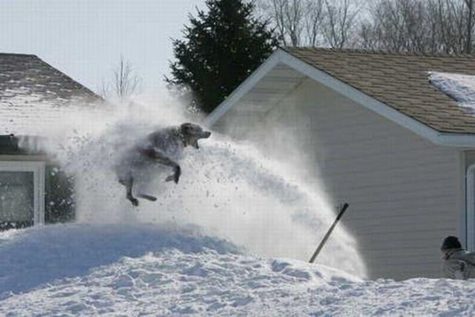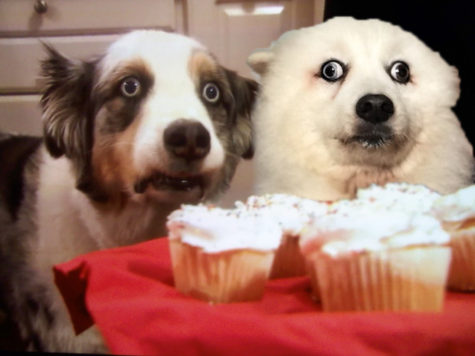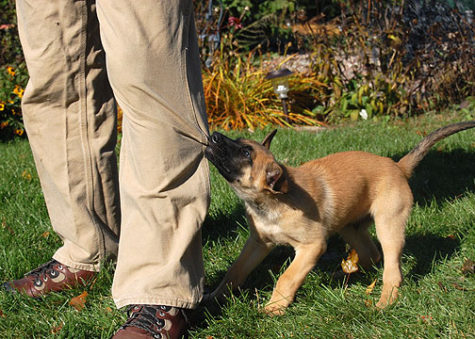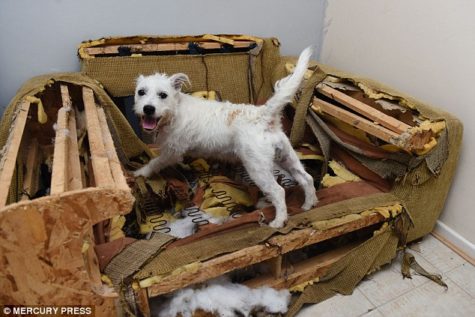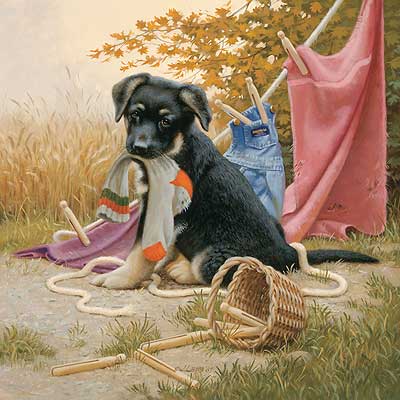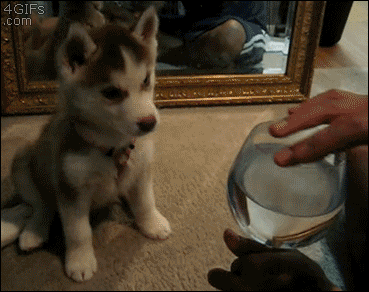Problem Solving
Cabin Fever
Not all dogs get out and enjoy winter weather like this guy! So, we thought it might be good to post the following article about cabin fever:
Going inside – and staying there – provides physical protection from the elements, but also opens the door to a mental hazard: boredom. A bored dog can wreak considerable havoc on his household in the form of excessive barking, hyperactivity, and destructiveness. Worse still, if the dog’s efforts to relieve his boredom prompt him to partake of poisonous plants or other toxic substances, he’ll need immediate veterinary attention, and you are likely to face a significant bill.
To prevent such occurrences, be sure to dog-proof your home; in other words, put any toxic, hazardous, or other forbidden items beyond your dog’s reach. Then, find ways to provide your dog with plenty of indoor physical and mental exercise. Here are some activities that you and your dog can do together indoors to help the two of you stay sane:
- Fetch:
A rousing game of fetch – particularly if it requires your dog to go up and down some stairs a few times – can give him a good physical work out.
- Tug-of-war:
As long as you are not having aggression problems with your dog, a good tug session can siphon off considerable excess canine energy. Rules of the game: The person needs to start the game, the person needs to end the game, and most of the time the person needs to win the game.
- Hide the toy:
To give your dog a mental workout, try hiding a toy or treat and then directing him to find it. Hold the item for him to see, then place him in another room so he can’t see where you hide the object. Once you’ve hidden the toy, allow him to come out and look for it. When teaching this game, put the toy or treat in plain sight, gradually increase the difficulty until your dog understands how to look for it.
Source: The Family Dog
Teaching Your Puppy “Leave It”
What it means:
Get that little nose out of there.. away from my food… out of the trash can… etc
Verbal command – “Leave It!” or “Out!”
Tone of voice – Sharp, firm, demanding
Hand signal – none
During the teaching phase, a release command is also taught.
Verbal command – “OK!”
Tone of voice – Friendly, encouraging
Hand signal – none
Body Language:
When teaching this command, you can be either standing or sitting. For best results, your puppy should be in front of you, with a leash on. During the training stages of this command, it will be helpful to have someone else handling either the leash or the treat. It’s important that you radiate an air of relaxation and calm.
The Food Reward:
This command is taught with a treat. For best results, use a “people food” treat that can be cut into very small pieces. Chunks of cheese or chicken work well. Most importantly, the food must be something that smells really good, tastes really good, and does not in any way resemble treats you normally use for training. It should also be something that is easily and quickly eaten.
How to do it:
Best taught with two people. One person is in charge of handing out the treat. The other person is in charge of administering the correction. If you do this by yourself, hold the treat in one hand, and the leash in the other. Holding the treat firmly with your thumb and forefinger, hand the treat to the puppy, saying “OK!” as you do this, and when the puppy reaches for the treat, let him have it. Do this 3 or 4 times to get the puppy excited and interested in this new game of “free” food.
Now it’s time for the “Leave it!” or “Out” command. Do everything exactly the same way as you did the 3 or 4 times previously, hold the treat the same way, hand it toward your puppy the same way, BUT instead of saying “OK!” and letting the puppy have the treat, say “Leave it!” or “Out.” As you say the command, the person handling the leash simultaneously jerks the puppy back and away from the treat.
It’s best if the “Leave it!” command and the jerk of the leash happen at the same time. This will surprise and startle the puppy. Do not move your hand, the one holding the treat, or jerk it back. Leave it where it is and give your puppy a few seconds to decide what to do next. If the puppy goes in for the treat again, repeat the “Leave it!” and the jerk. If the puppy tries to run away, grab him and give him lots of hugs, kisses, love, belly rubs, and praise.
Now, repeat the procedure with the “OK!” 3 or 4 times. More if the puppy is hesitant to take the treat, less if the puppy is still determined to grab it. When the puppy is taking the treat with no hesitation, repeat the procedure with the “Leave it!” and the jerk on the leash.
If your puppy immediately backs away from the treat. Give lots of love and praise, and repeat the “OK!” procedure 3 or 4 times. If your puppy goes for the treat when you say the “Leave it” command. Repeat the “Leave it!” procedure again, only this time use a sharper jerk on the leash. A very determined puppy may have to practice the “Leave it” command several times in a row before he will willingly back off without a correction.
Do the commands as a series of 3 or 4 of the “OK!” commands followed by 1 or 2 of the “Leave it!” commands until your puppy is happily taking the treat with the “OK!” and not the least interested on the “Leave it!”
End the training session on a positive note with several “OK!” commands.
Do’s and Don’ts:
Do not allow your puppy to grab and eat the treat unless or until you have given the “OK!” If your puppy does manage to get the treat out of your hand, you will have to pry his mouth open and dig it out. If it is already swallowed, do this anyway – as if you are fully prepared to go in after it.
Do not jerk your hand back or away when you say “Leave It.” You don’t want your puppy to key into anything you might consistently do with your hand. You want your puppy to respond only to the verbal command, not a hand movement. Because of this, it’s very important that you hand and hold the treat exactly the same way for both the “Leave It” command and the “OK!” command.
The best time to teach this command is when your puppy is hungry.
When to Use this Command:
When your puppy has learned what “Leave it!” means, and is reliable off leash when working with a food in a controlled environment, you can begin to use it in every day practical situations. It will be really helpful if you set your puppy up with a series of temptations while on leash so that you can step in to correct if need be.
Use and enforce this command any time your puppy is interested in something they might want to eat (or sniff) that is inappropriate, or unacceptable. Examples include: The litter box, garbage can, ice cream cone in a toddler’s hand, a plate of snacks on the coffee table, rabbit poop… I’m sure you can think of a few more.
What your puppy learns:
It is never OK to grab food out of the hands of anyone without permission. Your position of authority is reinforced by the concept that you are in charge of what, and what is not, acceptable to grab and eat.
Written by: Shirley Gibson
Note:
You are welcome to share this post but ONLY IF you give credit and a link back to Teach Your Dog To Behave or shirleytwofeathers.com.
Teaching Your Puppy Not To Bite
What it means:
Do not bite me (her, him, it).
- Verbal Command: “NO BITE!”
- Tone of voice: Sharp, firm, demanding, stern
- Hand Signal: None
Body Language:
Self confident commanding
Enforcing the command:
Grab the puppy firmly around the muzzle, holding his mouth shut, give direct eye contact, hold the puppy firmly in place until all resistance stops and the puppy looks away. As you do this, say “No Bite” in a sharp, firm tone.
If this is ineffective (and it will be for some puppies), pinch the skin of the muzzle into the puppy’s canines (eye teeth). This should be done firmly enough to make the puppy whine. Again, repeating the “No Bite” command.
As soon as the puppy stops resisting the correction – praise the puppy, and stroke the muzzle and face. Do this in the same way that a mother dog might lick her puppy’s face. If the biting recurs, repeat the correction. If the biting stops, and especially if it is replaced by licking, praise the puppy some more and reward with a tummy rub or toy.
Alternative Enforcement Methods:
For aggressive puppies that enjoy a contest of wills, try using a squirt bottle with a 50% lemon juice or Tabasco, and squirt it directly into the puppy’s mouth as he is biting. Be very careful to avoid the puppies eyes. Putting the puppy immediately into a long down stay is also quite effective.
What Your Puppy Learns:
Self control, and to inhibit biting behavior. Pinching the skin of the muzzle into the eye teeth sounds rather severe, but actually, it stimulates the same correction a mother dog uses to stop puppies from biting instead of sucking when they get their teeth in. The only difference is that she will actually bite the puppy on the nose. Not hard enough to injure the puppy, but certainly hard enough to cause the puppy to cry out. She will then very earnestly lick his little face, soothe his worried soul, and once again all will be well in his world.
Other info:
Puppies taken from their mother and siblings too early will often engage in a lot of biting behavior, presumably because the mother dog was not available to teach the puppy that biting too much, or too hard is not OK.
Written by: Shirley Gibson
Note:
You are welcome to share this post but ONLY IF you give credit and a link back to Teach Your Dog To Behave or shirleytwofeathers.com.
Chewing Problems?
Chewing appears to be an enjoyable behavior for nearly all puppies and many older dogs. In the young pup, healthy development of nervous and muscle tissue, as well as proper teething, depends on vigorous chewing exercise. In animals of all ages chewing is an important part of eating, investigation, and protection from entrapment.
Most puppies are basically a set of teeth with skin, hair, and other appendages attached somewhere behind. These guys play, release tension, eat, defend themselves, and explore the environment with their mouths. You must be prepared to accept the fact that puppy chewing may extend well into the first year of life, and will be directed toward everything within reach.
If you do not want to be faced with a situation such as the one pictured above, it will be important to provide the following:
Supervision and Confinement
The first important principal in preventing chewing problems which is that constant supervision or confinement must be consistently provided until the puppy is older and can be completely trusted. Until that time arrives, it is absolutely essential that the puppy be closely supervised 100% of the time when loose in the house, and when supervision is not possible, the puppy must be confined in a crate or safe area.
Now, let’s talk about supervision. For some owners, supervision means being in the same galaxy with the puppy. Fortunately, most owners realize that they need to at least be home to supervise. Here’s the thing… even being in the same room with a puppy is not the same as constant supervision, especially if the owner is on the phone, watching television, or otherwise engaged. Supervising a puppy means that eyes must be on the puppy at all times.
Puppies move very quickly and the time that it takes to grab something off the stove, or answer the phone is more than enough time for the puppy to eat a favorite book, destroy the couch, or chew into an electric cord.
Be aware of what your puppy is doing at all times. One way to achieve this is to keep the puppy on a leash or a tie out that allows for movement and exploration in an area that has been “puppy proofed.”
When adequate supervision cannot be provided, the puppy must be confined. Confinement areas can include a pen or a crate. Confinement is important when you are not at home, or if you are too busy to attend to the puppy properly. Just be aware that constant confinement teaches your puppy NOTHING, and undermines your relationship.
Acceptable chew toys
An acceptable chew toy is attractive to the puppy, virtually indestructible, safe and dissimilar to other objects around the house that the owner does not want chewed. This immediately removes from consideration such items as old shoes, stuffed toys, flimsy toys, and dad’s old socks. These types of items make it more difficult for the puppy to distinguish between the puppy’s toys and the owner’s things.
The number of toys which are provided is also important. I have found that three toys at a time are adequate. Too many toys at a time give the puppy the false impression that every item in the house is probably one of their toys. At the same time, puppies will sometimes get bored with the same old stuff, so it’s a good idea to switch things up every day or two by swapping toys. If an old favorite goes away for a few days and then suddenly reappears, it’s almost as good as a brand new toy.
Puppy-Proofed Environment
It is important that all areas accessible to a puppy are puppy-proofed. Any objects that are dangerous or precious should be kept out of the reach of an exploring puppy. An object that was ignored all last week might suddenly become interesting and exciting next week. So take your puppy proofing seriously.
If the puppy develops a habit of chewing on furniture, wall molding or other objects that can’t be put out of reach, these may be painted with cayenne pepper paste, oil of citronella, or any of a variety of “no chew” products.
Avoid Contributing to the Problem
Besides guiding the puppy’s chewing in the right direction with proper chew toys, and taking measures to prevent mistakes with supervision, confinement, and a puppy-proofed environment, it is also very important that you do nothing to encourage excessive chewing tendencies. Teasing, tug of war games, and corrections given too long AFTER the inappropriate chewing can all contribute to unwanted chewing.
Certain puppies are just more oral than others and this tendency, coupled with stressful situations, can produce tension which may be released by chewing. Some situations which can cause excessive tension in puppies include highly emotional departures and homecomings by the owner, excessive attention from the owner, social isolation, boredom, and delayed feeding time.
Timely Correction
For correction to be used effectively, the aversive stimulus must be of an appropriate intensity and given with correct timing. Unfortunately, most dogs are punished too harshly and too late. The correction should be just enough to elicit a response from the dog, but not so strong that a high degree of anxiety is produced.
Timing is very important. The correction must be giving DURING the behavior to be effective. If the delay between behavior and correction is as little as 5 to 10 seconds, the puppy will learn, but the learning will be slow. If the delay is as long as several hours, the puppy will not have a clue as to what the correction was for, and may even attach the correction to a completely different circumstance.
Teaching Self Control
Teaching your puppy some basic commands goes a long way to helping your puppy learn a measure of self-control. These commands could and should include : Sit, Stay, Down, and Come. Of these commands, the Stay command is the most important as it teaches your puppy that you mean what you say when you say it.
Adapted from an article written by Dr. Wayne Hunthausen
Chewing and Play Biting
Chewing and play biting, how to control it and what do do about it.
STEP 1
Understand the causes – knowing WHY will help you decide WHAT to do.
- If your puppy has an aggressive temperament, chewing and play biting will be a favorite activity.
- Retrieving dogs are very oral, and often do not feel comfortable unless they have something in their mouths.
- Some dog breeds, such as terriers, were bred to catch and kill small game. They have an inbred instinct to “kill” their toys, and whatever they perceive to be “toys.”
- Nervous, anxious puppies sometimes engage in destructive chewing because it helps to relieve anxiety. This is very similar to the nervous habit of chewing on fingernails. When I was in grade school, I regularly chewed on my pencils when taking tests that I didn’t feel prepared for – some puppy chewing is triggered the same way.
- Puppies that are taken from their mother and litter-mates at the age of 5 weeks or younger have missed a critical developmental period. If this is the case, you will have to work longer and harder on the biting problem.
STEP 2
Take appropriate action – do not sit back and expect that your puppy will suddenly “grow out of it.”
If your puppy is bored, teething or full of nervous energy:
- Provide good chew toys, but not too many at a time, and alternate them.
- Wear your puppy out with lots of play and exercise.
- Find a play group with friendly dogs for your puppy to play with.
- Spend some time teaching and reinforcing “Drop It” and “No Bite”
If your puppy gets wired, and goes berserk biting and chewing:
- Avoid wild games and tug-of-war.
- Use correction followed by a short obedience session.
- Be careful that you are not inadvertently praising your puppy for this behavior.
- Insist that your puppy stop when YOU say so.
- Take your puppy for a long walk.
- Find a play group with friendly dogs for your puppy to play with.
- Give your puppy some “time out” in the crate or other secure area.
- You may need to use some stronger corrections, even a good shake by the scruff of the neck. (Do not use this correction with an aggressive puppy, it may escalate the problem.)
If your puppy is regularly picking out specific items to chew on:
- Treat the object (and / or similar ones) with a bitter tasting substance.
- Spend some time teaching and reinforcing “Drop It”
- Devise a booby trap. For example, a cascade of plastic bottles partly filled with pennies (for a noisy landing) and tied together with string might suddenly fall on a puppy busily engaged chewing on the chair leg.
- Use a squirt bottle or shake can and keep it handy.
- Do not leave the puppy alone or unattended with access to things he likes to chew up. This will only teach him that chewing is fun and OK when you aren’t around.
- Do give the puppy plenty of access to things he likes to chew up when you ARE around and PAYING ATTENTION. This will give you plenty of opportunities to teach your puppy what IS and what IS NOT acceptable chewing material.
If your puppy is chewing on you to get attention:
- Try to spend some quality time every day with your puppy.
- Teach your puppy to “fetch,” play ball, or other suitable games.
- Take time to work on some obedience commands with your puppy.
- Find a play group with friendly dogs for your puppy to play with.
- Use distractions, or take your puppy for a long walk.
If your puppy chews on you to stop you from doing something:
- Do not allow this behavior to work for your puppy.
- Be firm and consistent with your corrections.
- Work on building a relationship based on trust and respect.
Important Points:
- Remember, chewing is normal puppy behavior.
- Dogs play bite when they play with each other. It is up to you to teach your puppy that humans do not play the same way as dogs.
- Do not OVER correct chewing behavior if it is caused by anxiety or nervous tension. This will make your puppy even more nervous, and the problem could escalate.
- Do not UNDER correct play biting and mouthing as a form of dominance. Assert yourself now, or you will have bigger problems later.
- Provide plenty of fun alternatives, praise your puppy when he uses them.
- Make sure your puppy gets plenty of physical exercise. A tired puppy is a sleeping puppy. And a sleeping puppy is not chewing or biting.
Written by: Shirley Gibson
Note:
You are welcome to share this post but ONLY IF you give credit and a link back to Teach Your Dog To Behave or shirleytwofeathers.com.
